|
|

|
|
Author
|
Topic: Adler Planetarium: Shoot for the Moon
|
Robert Pearlman
Editor Posts: 43485
From: Houston, TX
Registered: Nov 1999
|
 posted 11-11-2006 03:35 PM
posted 11-11-2006 03:35 PM
   
Adler Planetarium release Adler Planetarium Opens Shoot for the Moon Exhibition on November 11, 2006It's been 34 years since Chicagoan Eugene Cernan left the last footprints on the Moon, but we are quickly approaching the day when humans will return to the lunar surface. What role will you play in the next great space adventure? Find out in Shoot for the Moon, a new permanent exhibition at the Adler Planetarium. 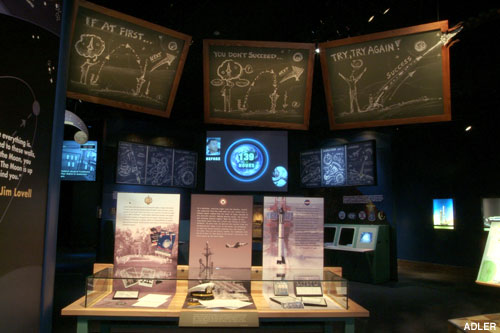 Shoot for the Moon highlights the exciting stories of space exploration and America's bold plans to return to the Moon. Shoot for the Moon opens to the public on Veterans' Day, Saturday, November 11, 2006 &mdash the 40th Anniversary of the Gemini 12 mission. General museum admission will be free for veterans and active military on November 11, 2006 in honor of Veterans' Day.
"America's plans to return to the Moon, NASA's recent shuttle launches and some of the world's first 'space tourists' are creating public interest in space exploration," said Adler President Paul H. Knappenberger Jr., PhD. "We hope the Adler's Shoot for the Moon exhibition makes space history more accessible to young visitors and inspires them to imagine their own futures as explorers."
Shoot for the Moon is the dramatic first expression of the Adler Planetarium's new institutional vision to be the world's leading space science center. The exhibition begins with A Journey with Jim Lovell, featuring the fully-restored Gemini 12 spacecraft and the Lovell Collection of personal space artifacts. In Mission: Moon, young visitors discover the thrills and dangers of being an explorer and imagine their own futures in space. BRC Imagination Arts is designing and producing the Shoot for the Moon space exploration experience for the Adler Planetarium.
"Growing up near Chicago, the Adler inspired me to think about becoming a space explorer one day," said Captain James A. Lovell, Jr. "In turn, I hope this new exhibit introduces today's young people to the thrill of space exploration and inspires them to become a part of humankind's return to the Moon." 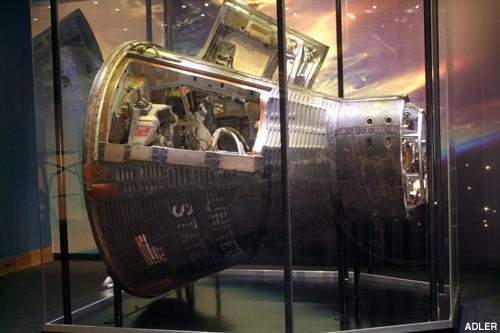 The fully-restored Gemini 12 spacecraft, flown by Lovell and Dr. Buzz Aldrin in 1966, is the centerpiece of Shoot for the Moon. Lovell and Aldrin will celebrate the 40th Anniversary of the Gemini 12 mission at the Adler; and reunited with the Gemini 12 spacecraft for the first time since their historic mission in 1966, the two astronauts will dedicate the exhibition to the next generation of explorers.
"Every generation should have the opportunity to experience the wonders of space travel," said Aldrin. "Exhibits like the Adler Planetarium's Shoot for the Moon are a critical part of building public enthusiasm for NASA's scientific and exploratory missions and the new space tourism market." A Journey with Jim Lovell
A Journey with Jim Lovell shares the story of America's first journeys into space in the 1960s as told through the powerful narrative of Lovell. It includes the personal stories of Lovell's initial failures to gain acceptance into the U.S. Naval Academy and NASA astronaut program, and his ultimate triumphs flying on four spaceflight missions and traveling to the Moon twice. Visitors will gain insights about the dramatic moments leading up to each of his Gemini missions and learn how Lovell and others risked their lives to advance scientific understanding when manned space flight was still in its infancy.
A Journey with Jim Lovell first introduces visitors to a young boy from Milwaukee who would grow up to become an American hero. They will learn about his childhood interests and find out how Lovell's perseverance as a young adult got him through a series of setbacks that included initial rejections by the Naval Academy and NASA's astronaut program. Visitors will understand the life- threatening risks Lovell took during his time as a Navy test pilot and as an astronaut in the Gemini and Apollo programs.
As a teenager, Lovell discovered a passion for rocketry and wrote to the American Rocket Society (ARS) to ask about becoming a rocket engineer. The ARS replied that Lovell should go to MIT or Cal Tech. But Lovell, raised by a single mother, could not afford those schools. Instead he applied to the Naval Academy in Annapolis, but was rejected. After the United States Navy placed Lovell on an alternate list, he entered college at the University of Wisconsin-Madison under the Navy's Holloway Plan, which allowed him to take flight lessons while pursuing his education. After two years at the University of Wisconsin-Madison in the Navy's ROTC program, Lovell applied to the Naval Academy again and was accepted.
In 1959, Lovell was invited to a secret meeting to try out for a spot on America's first roster of astronaut pilots. After a week of grueling tests, Lovell failed his physical exam because of a medical technicality. From his television at home, Lovell watched as the Mercury 7 were proclaimed America's first astronauts.
But Lovell's perseverance eventually paid off. Three years later, in 1962, NASA again called for astronaut candidates and Lovell reapplied. This time, he passed all the tests. Jim Lovell was now officially an astronaut in training.
"First, if you want to be successful as an astronaut or anything else, you have to keep trying. There will be disappointments in your life. You'll get so far and then there will be a setback. And if you let the setback overcome your drive, your willpower, then you're in trouble," said Lovell.
Mission: Moon
Mission: Moon continues the story from the Gemini program to focus on the historic accomplishments of the hugely successful Apollo missions, which saw America reach its goal of landing a man on the Moon. A Lunar Dangers Training Lab invites young visitors to serve as members of an exploration team going back to the Moon in the 21st century. A Lunar Leap, Touch Down interactive and other state-of-the-art exhibit elements allow visitors to discover the thrills and challenges of lunar exploration and imagine their own futures in space.
Prominent in the gallery are four of the Apollo missions: Apollo 8, the first crewed mission to orbit the Moon; Apollo 11, when Neil Armstrong and Aldrin became the first humans to walk on the Moon; the ill-fated Apollo 13 mission when Lovell returned his crew safely to Earth after a life-threatening onboard explosion; and Apollo 17, mankind's last Moon landing. In the Lunar Dangers Lab, visitors will meet A.L.E.X. (Analyst of Lunar Environmental Extremes) an animated robot who thinks that he's ready to live on the Moon. ALEX goes through a series of rigorous tests in this special effects presentation to see if he can survive the dangers of the Moon, which include: Temperature Extremes, Solar Radiation, Micrometeorites and Lunar Dust. The scientific content of this segment is narrated by Lovell and delivered with visual puns and environmental special effects, making it fun and accessible for all ages. Shoot for the Moon Artifacts
The fully-restored Gemini 12 spacecraft flown by Lovell and Aldrin in 1966, is the centerpiece of a multimedia show celebrating the Gemini 12 mission and America's race to the Moon. Contextual exhibits surrounding the spacecraft tell stories about the Gemini 12 mission and the awe-inspiring moments Lovell and Aldrin shared during their three days in space. Supporting objects, graphics and videos tell the background story of the Gemini program as a critical step on our way to landing on the Moon.
State-of-the-art technology brings the Gemini 12 spacecraft alive in a manner not seen anywhere else in the world. Designed and created by BRC Imagination Arts, the presentation plays on two large projection screens positioned above the Gemini 12 spacecraft. During the show, narrated by Lovell, visitors can relive some of the most exciting and ground-breaking moments of the Gemini 12 mission. As the show unfolds, key features of the spacecraft are brought to life with lighting effects in and around the capsule, which are choreographed with the video and narration. 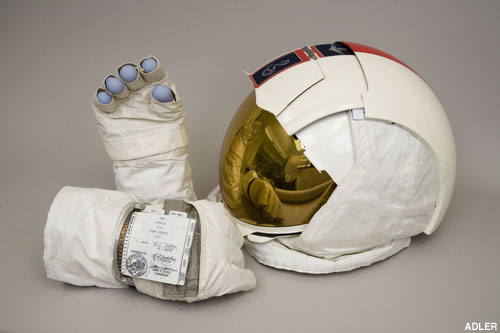 In addition to the Gemini 12 spacecraft, the exhibition includes artifacts and memorabilia from Lovell's personal collection, the National Air and Space Museum, Smithsonian Institution, NASA and the Oscar-winning film Apollo 13. Among the outstanding pieces in Shoot for the Moon are: an Apollo 8 in-flight suit, Apollo 13 helmet and gloves, Lovell's visual acuity test card from Gemini 7, original flight plans and manuals flown on the Gemini 12 mission, the Omega chronograph worn by Lovell on Gemini 12, an Apollo 11 pen light, an Apollo 15 Moon rock, Lovell's optical sight from Apollo 13, which ultimately saved the lives of the Apollo 13 crew, and the director's "clapper" used in the film Apollo 13. 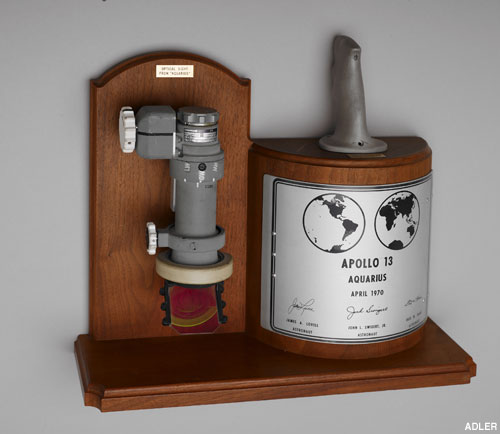 Also included are some of the rocketry and science fiction books that inspired Lovell as a child, as well as other personal effects from his early years, including photos and diaries.
The Adler Planetarium & Astronomy Museum &mdash America's First Planetarium &mdash was founded in 1930 by Chicago business leader Max Adler. The museum has announced a new vision to be the world's leading space science center. The museum will inspire the next generation of explorers by sharing the stories of human space exploration and America's space heroes. The Adler is a recognized leader in science education, with a focus on inspiring young people, particularly women and minorities, to pursue careers in science.
BRC Imagination Arts is designing and producing the new Shoot for the Moon space exploration experience for the Adler Planetarium. For more than 20 years, BRC Imagination Arts has been the leader in the design, creation and production of innovative and immersive experience-based attractions for museums, experiential marketing, and cultural heritage sites worldwide. Their previous work includes the Kennedy Space Center visitor complex and the Abraham Lincoln Presidential Library & Museum. |
Robert Pearlman
Editor Posts: 43485
From: Houston, TX
Registered: Nov 1999
|
 posted 07-29-2006 04:50 PM
posted 07-29-2006 04:50 PM
   
Adler Planetarium release Take a journey alongside NASA astronaut Captain James A. Lovell, Jr. in A Journey with Jim Lovell — the summer preview of the first gallery of the Adler's new exhibition Shoot for the Moon. This permanent exhibition tells the inspiring story of astronaut Jim Lovell's life and career using artifacts from his personal collection. The fully-restored Gemini 12 spacecraft flown by Captain Lovell and Buzz Aldrin in 1966 is the centerpiece of a multimedia show celebrating the Gemini 12 mission and America's race to the Moon. "I hope this exhibit introduces young people to the thrill of space exploration," said Lovell. "The Gemini program was the gateway to the Apollo program — without it, we might never have sent men to the Moon."
A Journey with Jim Lovell shares the story of America's first journeys into space in the 1960s as told through the powerful narrative of Lovell. It includes the personal stories of Lovell's initial failures to gain acceptance into the U.S. Naval Academy and NASA astronaut program and ultimate successes flying on four spaceflight missions and traveling to the Moon twice! Visitors will gain insights about the dramatic moments leading up to each of his Gemini missions and learn how Lovell and others risked their lives to advance scientific understanding when manned space flight was still in its infancy.
"Jim Lovell is an American hero whose contributions to space science and our national pride are immeasurable," said Adler President Paul H. Knappenberger Jr. PhD. "The Adler is honored to share his important story and use his experiences to inspire the next generation of explorers." If at first you don't succeed... A Journey with Jim Lovell first introduces visitors to the young boy from Milwaukee who would grow up to become an American hero. They will learn about his childhood interests and find out how Lovell's perseverance as a young adult got him through a series of setbacks that included initial rejections by the Naval Academy and NASA's astronaut program. Visitors will learn about the life-threatening risks Lovell took during his time as a Navy test pilot and as astronaut in the Gemini and Apollo programs.
As a teenager, Lovell discovered a passion for rocketry. What kid in his right mind would have the audacity to walk into the Michigan Avenue offices of a major chemical company to ask about purchasing the ingredients for rocket fuel? Lovell was escorted out of the building without them, after being told that they add up to gunpowder. With his passion for rocketry ignited, a young Lovell wrote to the American Rocket Society (ARS) to ask about becoming a rocket engineer. The ARS replied that Lovell should go to MIT or Cal Tech. But Lovell, raised by a single mother, could not afford those schools. Instead he applied to the Naval Academy in Annapolis, but was rejected. After the United States Navy placed Lovell on an alternate list, he decided to enter college at the University of Wisconsin-Madison under the Navy's Holloway Plan, which allowed him to take flight lessons while pursing his education. After two years at the University of Wisconsin-Madison in the Navy's ROTC program, Lovell applied to the Naval Academy again and was accepted.
In 1959, after making amazing headways during this part of his life, Lovell was invited to a secret meeting to try out for a spot on America's first roster of astronaut pilots (those who would eventually become the Mercury 7). After a week of grueling tests, Lovell failed his physical exam because of a medical technicality. From his television at home, Lovell watched as the Mercury 7 were proclaimed America's first astronauts. ...try, try again But Lovell's perseverance eventually paid off. Three years later, in 1962, NASA again called for astronaut candidates and Lovell reapplied. This time, he passed all the tests. Jim Lovell was now officially an astronaut in training. "First, if you want to be successful as an astronaut or anything else, you have to keep trying. There will be disappointments in your life. You'll get so far and then there will be a setback. And if you let the setback overcome your drive, your willpower, then you're in trouble," said Lovell. Exhibition artifacts A Journey with Jim Lovell ends with a multimedia show celebrating the history-making Gemini 12 mission. State-of-the-art technology brings the spacecraft alive in a manner not seen anywhere else in the world. Designed and created by BRC Imagination Arts, the presentation plays on two large projection screens positioned above the Gemini 12 spacecraft. During the show, narrated by Lovell, visitors can relive some of the most exciting and ground-breaking moments of the Gemini 12 mission. As the show unfolds, some key features of the spacecraft are brought to life with lighting effects in and on the capsule, which are choreographed with the video and narration. Behind the spacecraft stands a floor to ceiling backlit wall featuring a breathtaking photograph of Earth taken from one of the Gemini missions. Contextual exhibits surrounding the capsule tell stories about the Gemini 12 mission and the awe- inspiring moments Jim Lovell and Buzz Aldrin shared during their time in space. Supporting objects, graphics, text panels and videos tell the background story of the Gemini program as a critical step on our way to landing on the Moon.
In addition to the Gemini 12 spacecraft, the exhibition includes almost 30 artifacts from Captain Lovell's personal collection. Among the outstanding pieces in A Journey with Jim Lovell are: Lovell's Naval Academy term paper on using liquid fuel as a rocket propellant, his rejection letter from the Mercury Program in 1959, original flight plans and manuals flown on the Gemini 12 mission, Lovell's visual acuity test card from Gemini 7, Gemini mission patches, Lovell's handwritten Gemini training notes and a full set of Gemini space program medallions.
Also included are some of the rocketry and science fiction books that inspired Lovell as a child, as well as other personal effects from his early years. Look for his handwritten diaries and personal photos, including one of his high school study group. History of the exhibition On April 13, 2005, Captain Lovell announced he would consolidate his personal collection and contribute it to the Adler Planetarium. This collection included important documents, memorabilia and personal space artifacts.
"The Adler inspires young and old alike to learn about space science which contributes to our national identity as a science and technology leader," Lovell said. "I can't imagine a better use of my collection than in this noble effort."
Captain Lovell also helped the Adler secure the Gemini 12 spacecraft on long-term loan from the Smithsonian National Air and Space Museum. The spacecraft -- one of four flown by Lovell in his career as an astronaut -- was previously housed at NASA's Goddard Space Flight Center in Greenbelt, Maryland. At the request of Captain Lovell, it was approved for relocation to the Adler in 2005.
As part of the loan agreement, the Adler helped direct the conservation of the spacecraft. The Gemini 12 spacecraft was sent to the Kansas Cosmosphere and Space Center in Hutchinson, Kansas, for restoration and preservation. Restoration of the capsule, which took almost four months, included taking an inventory of the spacecraft's parts and condition, fixing some corrosion on the body, as well as some of the wear and deterioration visible on the interior. This was the third Gemini capsule the Cosmosphere's shop has restored. The others were Gemini 6 and Gemini 10.
"It is an honor for the Adler to be asked to display and assist in preserving a national treasure like the Gemini 12 capsule and be able to bring it to the city of Chicago," said Knappenberger. "The fact that Captain Lovell personally flew this spacecraft and asked that it be relocated to the Adler is a testament to his commitment to exposing the thrill of space travel to a new generation."
Captain Lovell personally met with restoration experts at the Cosmosphere to go over details of the work and make sure the capsule was brought back to its post-flight appearance. He helped guide both the conservation of the Gemini XII spacecraft and the development of the exhibition.
"We don't want it shiny," Lovell said. "What makes this spacecraft important is that it has been to space and back. We don't want it to look brand new. We don't want it to look like a new nickel." Shoot for the Moon grand opening A Journey with Jim Lovell is the first, dramatic expression of the Adler Planetarium's new institutional vision to be the world's leading space science center. The museum is committed to sharing Captain Lovell's important story with today's young people. His hard work and dedication set a powerful example that will inspire the next generation of explorers.
The grand opening of the full Shoot for the Moon exhibition will open to the public on Veteran's Day - November 11, 2006 - the 40th anniversary of the Gemini 12 mission. It will offer visitors the opportunity to walk in the boots of an explorer -- experiencing the thrill of trying out for the astronaut program and flying in space.
The Adler Planetarium & Astronomy Museum -- America's First Planetarium -- was founded in 1930 by Chicago business leader Max Adler. The museum has announced a new vision to be the world's premier space science center. The museum will inspire the next generation of explorers by sharing the stories of human space exploration and America's space heroes. The Adler is a recognized leader in science education, with a focus on inspiring young people, particularly women and minorities, to pursue careers in science. BRC Imagination Arts is designing and producing the new Shoot for the Moon space exploration experience for the Adler Planetarium. For more than 20 years, BRC Imagination Arts has been the leader in the design, creation and production of innovative and immersive experience-based attractions for museums, experiential marketing, and cultural heritage sites worldwide. |
canyon42
Member Posts: 238
From: Ohio
Registered: Mar 2006
|
 posted 07-31-2006 05:05 PM
posted 07-31-2006 05:05 PM
   
I visited the Adler for the first time in April -- none of the "new" exhibition was open yet, a big section of the planetarium was closed off. I found out later that the capsule was supposedly delivered about the same time we were there -- kind of disappointing! |
John Youskauskas
Member Posts: 126
From:
Registered: Jan 2004
|
 posted 07-31-2006 09:24 PM
posted 07-31-2006 09:24 PM
  
I was just there July 16th... a very nice start to the exhibit. At the entrance is a life-size bronze sculpture of Lovell in his Apollo 13 CWG "floating" toward a framework shaped like a LEM window. It is very impressively detailed with a checklist fanned out in a zero-G effect and a lunar glove tumbling nearby.The rest of the exhibit included various flown artifacts, including a lucite with flown Robbins medallions from all 10 Gemini flights and some heatshield lucites. A bit off target was an entire glass case devoted to displaying one fecal containment unit... The GT-12 spacecraft is nicely displayed and lighted. You can walk full circle around the glass and see all sides. That ship had been 20 minutes down the road from me at Goddard since I was a kid... now I have to fly to Chicago to see it! Dined at Lovell's of Lake Forest while in town too. I wondered if his collection from the restaurant would ultimately end up at Adler. I spent more time looking around there than at the museum, and the food is FANTASTIC. A real first class restaurant with outstanding service and staff. By the way, when you head to the men's room don't miss the oversized cover of Time magazine on the wall just outside... at some point Bill Anders strolled by and added some rare personal graffiti! |
dabolton
Member Posts: 419
From: Seneca, IL, US
Registered: Jan 2009
|
 posted 02-08-2011 06:40 PM
posted 02-08-2011 06:40 PM
  
I was a Space Flight Docent from 2008 to 2009 on Shoot for the Moon. I basically ran a science cart with some flown artifacts, shuttle food, and a shuttle tile I got to light up with a torch. Good times. Never got to meet Lovell though. |
dabolton
Member Posts: 419
From: Seneca, IL, US
Registered: Jan 2009
|
 posted 09-08-2012 03:20 PM
posted 09-08-2012 03:20 PM
  
The road outside the Adler Planetarium has been renamed in Jim Lovell's honor. We are happy to announce the drive in front of the Adler has a brand new name. Congrats to Captain James A. Lovell Jr.! 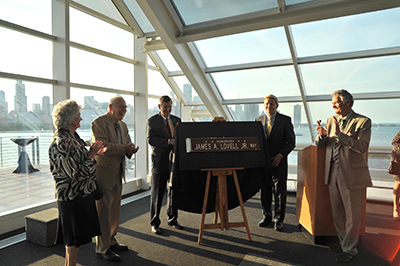 | |
Contact Us | The Source for Space History & Artifacts
Copyright 2020 collectSPACE.com All rights reserved.

Ultimate Bulletin Board 5.47a
|
|

|
 advertisement advertisement

|
















